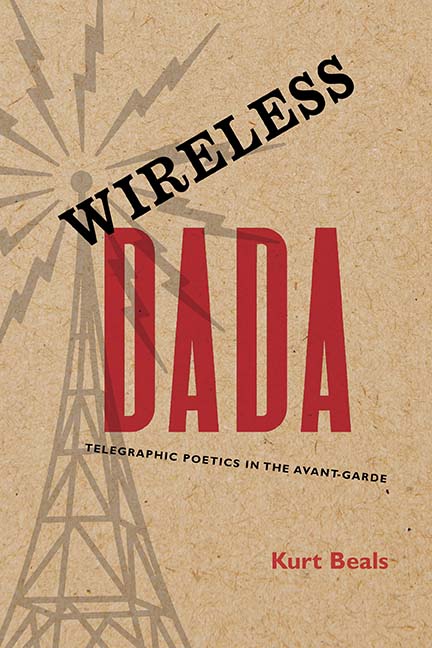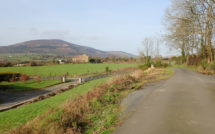
 The European avant-gardes exploded onto the scene in the decade leading up to the Great War and imposed new visions of art and culture in the decades after it. A century later, authoring a study on these movements is no small task—shelves of bibliography, decades of debate, volumes of well-worn conceptual schemas, many of them first theorized or thematized by the avant-gardists themselves. This makes Kurt Beals’ achievement in Wireless Dada all the more notable. His examination of how the telegraph inspires, frames, fuels, and complicates Dadaist poetry runs the risk of feeling too familiar, of simply confirming time-tested theories of how technological modernity restructures the realm of the sensible, generating anxiety as well as the conditions of possibility for radical responses to the problems of modernity. Yet what Beals offers here is not only a richer and more fascinating picture of telegraphic poetics than has previously been available, but also a compelling demonstration that academic research does not have to invent a new paradigm to be significant.
The European avant-gardes exploded onto the scene in the decade leading up to the Great War and imposed new visions of art and culture in the decades after it. A century later, authoring a study on these movements is no small task—shelves of bibliography, decades of debate, volumes of well-worn conceptual schemas, many of them first theorized or thematized by the avant-gardists themselves. This makes Kurt Beals’ achievement in Wireless Dada all the more notable. His examination of how the telegraph inspires, frames, fuels, and complicates Dadaist poetry runs the risk of feeling too familiar, of simply confirming time-tested theories of how technological modernity restructures the realm of the sensible, generating anxiety as well as the conditions of possibility for radical responses to the problems of modernity. Yet what Beals offers here is not only a richer and more fascinating picture of telegraphic poetics than has previously been available, but also a compelling demonstration that academic research does not have to invent a new paradigm to be significant.
Beals’ argument is straightforward but important. On the one hand, he shows that Dada is profoundly influenced by the invention of the wireless telegraph, a claim that may not seem shocking in itself but which has never been systematically pursued in relation to Dada poetics. In this way, he offers a compelling account of how Dada not only reacts against but also shares in some of the key technological paradigms of preceding movements like Futurism. One outcome of this argument is a shift in our perspective on what motivates Dada “nonsense:” it is not just a question of rejecting war and the mechanizing logic of modernity that led Europe into its epochal conflict, for at the same time Dada was replicating and playing with the transformations to language and communication wrought by one of the key technologies of that same mechanized modernity. Another central insight comes from the way the book traces the nuances of technological modernity, developing a richer understanding of how technological progress is informed by and in turn nourishes a multifaceted spiritualist discourse. The telegraph, in this view, is only a short stone’s throw from telepathy; and both are touchstones for the reimagination of artistic communication in Dada—and in the broader cultural horizons of the European avant-gardes.
The scope of Wireless Dada is thus both narrow and simultaneously broadly encompassing. On the narrow end, the book delves into close and extended interpretations of a series of key Dada poems, ranging from a trilingual piece performed at the Cabaret Voltaire, “L’amiral cherche une maison à louer” (“The admiral looks for a house to rent,” by Richard Huelsenbeck, Tristan Tzara, and Marcel Janco) to sound poems like Hugo Ball’s “Totenklage” (“Lament for the Dead”) and Elsa von Freytag-Loringhoven’s “Klink – Hratzvenga (Deathwail),” to a nonsense sound poem like Ball’s “Karawane” (“Caravan”), to Raoul Hausmann’s elaboration of his own cryptopoetics. Each of these (and others) is analyzed at length, unlocking complexities within the texts and their performance histories while situating them in their social, political, and art-historical surroundings. Simultaneously, and in a feat of argumentative acrobatics, Beals expands out from this consideration of the poems’ contexts in a way that requires him to draw a richly layered picture of the broader European avant-garde moment by locating these texts in what he aptly describes as a “web of avant-garde literary influences” (113). From Futurist and Expressionist simultaneity to theosophical séances and scenes of warship cryptography, Wireless Dada envisions a transnational story with many characters—some authors, some texts, and others technologies, inventors, theorists, and figures of popular culture.
Dadaist artists and their contemporaries were troubled, invigorated, and inspired by the sense that there was a polyphonic chorus of (dissonant) voices traveling invisibly through the modern skies. René Milan described such a symphony of voices in the air in 1916, and Beals uses his description as a model for thinking about Dada responses to the telegraph—responses that assault the single-voiced text’s ideal of intelligibility. I would add that this model of a symphony of voices is likewise an effective figure for conceiving of Beals’ methodology, which moves swiftly across texts, languages, authors, movements, genres, and cultural spheres to amass an ensemble attesting to both the widespread predominance of the telegraph in the cultural imagination of the early 1900s as well as its suitability to the formal needs of a new Dada poetics. This method ultimately produces something similar to the productively dizzying scope and clarity of vision in Thomas Harrisons’ important comparative study of the emergence of a modernist sensibility, 1910: The Emancipation of Dissonance, or Hans Ulrich Gumbrecht’s fascinatingly complex view from In 1926: Living at the Edge of Time, or Marjorie Perloff’s similarly multifaceted and critically seminal account of The Futurist Moment: Avant-Garde, Avant Guerre, and the Language of Rupture. These approaches foreground a cultural moment in its intricate – occasionally overwhelming – multiplicity, producing not just a study of texts but a vision of technological change and its social and cultural manifestations.
Panoramic but precise, what enables Beals to walk this tightrope is the creative way that he elevates a new protagonist onto the stage of avant-garde studies, the telegraph itself. This spans from Expressionism’s Telegrammstil (telegram style) to Futurist “immaginazione senza fili” (“wireless imagination”) to the less-studied ways in which Dadaist writers engage in the visual, sonic, occult, and cryptographic connotations of the new means of communication. More than a red thread connecting disparate movements and figures across Europe, the telegraph emerges as a protagonist in its own right – a new technology that entails a shift in the meaning of language, which transforms from meaningful personal communication to the transmission of information. Engaging the work of Wolf Kittler, Beals posits a new understanding of Dada poetics rooted in this same shift, sharing, as it were, the paradigm of a technology that arose for practical reasons but developed into a model for artistic expression.
If Wireless Dada is something of an acrobatic feat holding together so many facets, it is not free of those suspended moments of tension when the audience waits, breathless, in fear of a coming fall. In some places, it seems that the method can result in overstatements of the centrality of the telegraph to a wider set of changes and problems emerging in modern Europe. For instance, the forces of technological modernity’s mechanization and the resulting dehumanization they impose on society has long been a key paradigm for understanding the horizons of avant-garde experiments and modernist responses; here, it can sometimes seem that those larger forces are reduced down to one element, the telegraph, which is actually a subset of those forces. Beals implicitly acknowledges this difficulty in his concluding chapter, where he qualifies his claim to note that “the ‘global’ reach of the Dada movement is modeled, at least in part, on that of the telegraph” (156). The qualifying phrase is doing essential work to narrow the scope of the book’s argument, but this does not ultimately detract from the rich effect of using the telegraph as a protagonist to chart this moment in cultural history. Similarly, in another step of his argument, Beals’ emphasis on the telegraph involves a kind of revisionist account of the more broadly spiritualist (or idealist) stance of a key modernist, the artist and theorist Wassily Kandinsky (101). While there is no doubt an indirect relation between Kandinsky’s spiritualist poetics and the telegraph, it would be an overstatement to see him as an example of the telegraph’s impact on modernist art, which would be to substitute the subset for the set containing it. The telegraph is one of many technologies that theorists and artists of the period latched onto to bridge an ideal beyond with the material actuality of the modern world.
Walking the tightrope might have its risks, but what ultimately emerges from these instances is that Beals’ account has the capacity to make us view the familiar in new terms by highlighting a component of what was already there and reconfiguring our narrative of the larger whole through the lens of that smaller part. The telegraph becomes a way to relate a diverse range of figures, movements, ideas, and texts, making an intervention not only into German and comparative literary studies but also intellectual history and media history. The concrete technology of the telegraph and the practices and types of human relations (and inhuman relations) it entails provide a new perspective on social, cultural, and linguistic change. Viewing artistic practice as part of a broader shift in communication technologies where meaning and personality give way to a system of nodes exchanging information, Wireless Dada helps us to uncover a new model for Dada poetics: the author is replaced with the transcriber, the cryptographer, the medium, and the telegraph operator. Not simply a movement protesting the destruction of war and the logic of industrial modernity leading to it, Dada is also a complex recognition of the new systems of information linking the globe and tying seemingly disparate creators into a network of vibrating voices filling the modern skies.
Michael Subialka is Assistant Professor of Comparative Literature and Italian at the University of California, Davis. His research focuses on the juncture of literature and philosophy in European modernism, and he is editor of the journal of the Pirandello Society of America, PSA.
Wireless Dada: Telegraphic Poetics in the Avant-Garde
By Kurt Beals
Publisher: Northwestern University Press
Paperback / 212 pages / 2020
ISBN: 9780810141063
Published on November 10, 2020.




